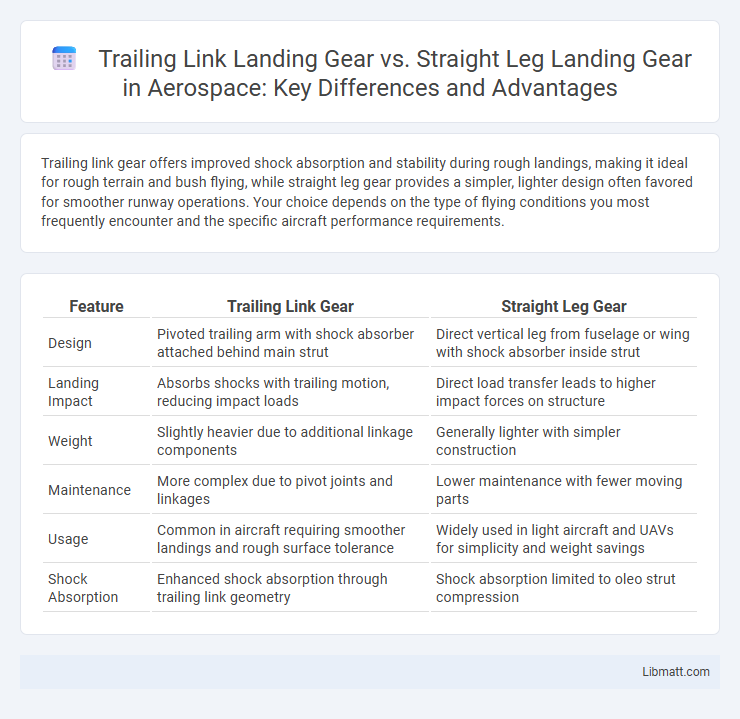Trailing link gear offers improved shock absorption and stability during rough landings, making it ideal for rough terrain and bush flying, while straight leg gear provides a simpler, lighter design often favored for smoother runway operations. Your choice depends on the type of flying conditions you most frequently encounter and the specific aircraft performance requirements.
Table of Comparison
| Feature | Trailing Link Gear | Straight Leg Gear |
|---|---|---|
| Design | Pivoted trailing arm with shock absorber attached behind main strut | Direct vertical leg from fuselage or wing with shock absorber inside strut |
| Landing Impact | Absorbs shocks with trailing motion, reducing impact loads | Direct load transfer leads to higher impact forces on structure |
| Weight | Slightly heavier due to additional linkage components | Generally lighter with simpler construction |
| Maintenance | More complex due to pivot joints and linkages | Lower maintenance with fewer moving parts |
| Usage | Common in aircraft requiring smoother landings and rough surface tolerance | Widely used in light aircraft and UAVs for simplicity and weight savings |
| Shock Absorption | Enhanced shock absorption through trailing link geometry | Shock absorption limited to oleo strut compression |
Introduction to Aircraft Landing Gear Configurations
Trailing link gear features a pivoting arm that absorbs landing shocks more efficiently, improving ride quality and ground handling for aircraft. Straight leg gear offers a simpler, more compact design with direct struts connecting the wheel to the airframe, commonly found on smaller or lighter aircraft. The choice between trailing link and straight leg configurations impacts landing stability, maintenance complexity, and overall aircraft performance during taxi, takeoff, and landing phases.
What is Trailing Link Gear?
Trailing Link Gear is a type of aircraft landing gear characterized by its main wheel axle being connected to the airframe via a trailing arm that pivots near the fuselage, allowing the wheel to move backward during landing impact for smoother shock absorption. This design offers improved energy dissipation and better handling on rough or unprepared surfaces compared to Straight Leg Gear, which has a rigid, vertically aligned strut attached directly to the fuselage. Trailing Link Gear enhances landing stability and reduces stress transmitted to the aircraft structure, making it popular in larger general aviation and utility aircraft.
What is Straight Leg Gear?
Straight Leg Gear refers to a modular hunting harness system featuring two suspension points connected by rigid or semi-rigid straps that maintain a fixed distance between the hip belts and shoulder straps. This design offers increased stability and weight distribution by minimizing twisting and shifting while climbing or moving through rugged terrain. Your choice between Straight Leg Gear and Trailing Link Gear impacts comfort and maneuverability during extended outdoor activities.
Key Design Differences
Trailing link gear features a suspension design where the wheel axle is connected behind the pivot point, enhancing stability and absorbing shocks more effectively during landing. Straight leg gear consists of a simpler structure with the landing gear legs extending straight down from the aircraft structure, resulting in less complex mechanics but potentially transferring more stress to the airframe. The trailing link's articulation allows for smoother touchdown and improved ground handling compared to the rigid nature of straight leg gear.
Advantages of Trailing Link Gear
Trailing link gear offers improved shock absorption and smoother landings by allowing the wheel to move rearward during compression, reducing stress on the airframe and enhancing durability. This design provides better stability and ground handling, especially on rough and uneven surfaces, making it ideal for cross-country flights and rugged terrain. Your aircraft benefits from increased comfort and reduced maintenance costs due to the efficient energy dispersion inherent in trailing link systems.
Benefits of Straight Leg Gear
Straight Leg Gear offers enhanced stability and precise weight distribution, reducing wear on both the equipment and surfaces it interacts with. Its design allows for smoother operation and easier adjustments in various industrial applications, improving overall efficiency. The simplicity of Straight Leg Gear also minimizes maintenance requirements, leading to lower operational costs.
Ride Quality and Comfort Comparison
Trailing link gear offers superior ride quality and comfort by absorbing bumps and road irregularities more effectively than straight leg gear, resulting in smoother landings. The trailing link design allows the wheel to move rearward and upward, reducing impact forces transmitted to the airframe and your body. In contrast, straight leg gear provides a simpler, lighter setup but often transmits more shocks, leading to a harsher ride experience.
Maintenance and Durability Considerations
Trailing link gear offers enhanced durability due to its simpler design and fewer moving parts, reducing maintenance frequency compared to straight leg gear. Straight leg gear, while lighter, typically requires more frequent inspections and maintenance because its components endure higher stress and potential fatigue. Maintenance costs tend to be lower for trailing link systems, making them preferable for long-term operational efficiency and reliability.
Applications and Aircraft Types
Trailing link gear is commonly employed in regional jets and turboprop aircraft due to its superior shock absorption and smooth touchdown capabilities, ideal for operations on rough or unpaved runways. Straight leg gear is prevalent in smaller general aviation aircraft and light utility planes, offering simplicity and lower weight suitable for stable surfaces and controlled flight environments. The choice between these landing gear types depends heavily on aircraft mission profiles and runway conditions.
Choosing the Right Gear for Your Aircraft
Trailing link gear offers superior shock absorption and smoother landings on uneven runways, making it ideal for rugged conditions and smaller aircraft. Straight leg gear provides a simpler, lighter design that is easier to maintain and often used in general aviation planes for improved aerodynamic efficiency. Choosing the right gear for your aircraft depends on balancing the need for durability, maintenance, and the type of terrain you frequently encounter.
Trailing Link Gear vs Straight Leg Gear Infographic

 libmatt.com
libmatt.com